Abstract
Scouring depends on several factors, including the water flow of artificial obstacles, sections, piers, and foundations, the disturbance of bed materials, and soil permeability. The other factors are the non-parallelism between piers and the water flow, the type of river activity (static or dynamic), and the existence of a waterfall or an obstacle that forms a waterfall in natural bed materials, causing the underlying bed materials to be washed away. This study fully investigated how the movement of a tree trunk affects a river’s flow by considering different flow conditions using the artificial neural network (ANN) model. A feedforward optimal network with the error back-propagation training algorithm and sigmoid transfer functions was used for four models. To determine the number of neurons in the hidden layer, one and ten neurons were selected in the hidden layer according to verification indicators. In addition, a physical model was utilized to measure data. To verify and test the models, our data were gathered in a laboratory using the physical model. Considering the network structure of one neuron in the hidden layer, a comparison was made between dimensional and dimensionless parameter models that are effective in terms of the dimensions of the scour hole. The comparison between the results of the ANN and the measured data using nonlinear regression models demonstrated that the ANN was more accurate and capable of simulating phenomena. Additionally, R and RMSE values were between 0.93 and 0.98, as well as 0.18 and 0.013, respectively. Finally, the results related to the width, height, length, and depth of the scour revealed that the modified DOT model had the best agreement with Mahdavizadeh’s measured data.
1. Introduction
Scouring is a natural phenomenon caused by water flow on erosive beds in rivers and channels. Local scour is also a part of the morphological changes of waterways, which mainly occurs due to various human-made structures. Experiments have shown that the scouring process can lead to the destruction of aprons and gradually bring about the conditions that cause the failure of the main structure due to shear failure and seepage of flow at the end of the protected bed.
Protecting beds against scouring is highly costly, especially for cases in which bed protection operations must be conducted underwater. Moreover, the length of the bed that needs protection depends on the allowable amount of scouring. Therefore, predicting the dimensions of the scour pit is extremely important. The flow where the scouring originates is a two-phase flow (water and sediment). Thus, the scouring is affected by a variety of variables, including the flow conditions, characteristics of the alluvial bed, time, and waterway geometry. Hence, researchers have studied and experimentally investigated these variables [1].
A large body of research has been conducted on the scouring of protected beds. Amini and Heydarpour [2] evaluated the similarity of scour profiles downstream of a hydraulic jump and presented a scour pit in terms of dimensionless profiles. Rajabi et al. [3] examined temporal changes in the local scour downstream of hydraulic structures and divided the development of holes into four stages. Hashemi et al. [4] studied scour development downstream of a spillway and concluded that there is no similarity between scour pit profiles. Amini and Mohammad [5] focused on the similarity of scour pits in different conditions and found that temporal changes in scour depth are exponential. They also observed that when the Froude number is high, the equilibrium depth of the scour pit is independent of the particle Froude number. Kashani et al. [6] investigated the downstream scour of a broad-crested weir with side slopes. They demonstrated that a reduction in the downstream depth causes a longitudinal expansion of the scouring characteristics. Moussa [7] concluded that the effect of the downstream depth on scour pit parameters depends on the value of the particle Froude number based on laboratory results obtained from the scouring of noncohesive sediment downstream of the apron.
Saber et al. [8], Mahdavizadeh et al. [9], Mahdavizadeh and Lim [10], Ali et al. [11] and Shen et al. [12] reported that for low heads, the efficiency of a spillway increases with the increase in the number of spillway openings. Jain and Fischer [13], Froehlich et al. [14] and Melville and Sutherland [15] showed that having an inlet opening larger than the outlet opening increases the flow discharge over spillways. Regarding our literature review, although many relevant papers have been published, few studies have been conducted on tree trunk deflectors in straight channels so far.
Despite previous investigations in this field, no study, to our knowledge, has addressed the downstream scour of spillways or provided comprehensive information about the characteristics of the downstream scour profile of spillways. Considering that less general criteria have been provided for predicting and controlling scouring in all possible states, establishing experimental and laboratory relationships is highly useful [16,17]. Meftah and Mossa [18] conducted research on a new approach to predicting local scour downstream of grade-control structures (GCSs). Their study experimentally focused on scour hole development downstream of a sloped GCS in alluvial channels. A large series of laboratory experiments were performed in a rectangular channel with a non-cohesive sediment bed [18]. Additionally, Meftah et al. published a paper relating to scour holes and found that anisotropy parameters are at the maximum near both the scour mouth and the scour bed, caused, respectively, by the grade control structure and sediment ridge formation, which play fundamental roles in maintaining and enhancing the secondary flow motion [19]. Furthermore, Meftah et al. [19] found a new scaling of the maximum scour depth at equilibrium, which was validated using experimental data, satisfying the validity of a spectral exponent equal to −5.3. The proposed scaling represents quite reasonable accuracy in predicting the equilibrium scour depth in different hydraulic structures [20]. This study aimed to fully investigate how the trunk movement affects the river flow by considering different flow conditions.
2. Research Objectives
Scouring studies have a long history in hydraulic science and river engineering. So far, many studies have addressed scouring downstream and around hydraulic structures in straight channels. However, the results of these investigations are extremely contradictory. Moreover, the scouring mechanism is considered a complex process due to multiple contributing factors; therefore, most research in this field is experimental and limited to estimations of the variables governing this phenomenon. However, due to the existing conditions and complexities, as well as the lack of a strong relationship responding to all conditions, it is still of special interest to researchers in hydraulic science and river engineering fields.
Most previous studies have focused on a single pier in a steady-state flow. The present research has attempted to investigate various experimental methods and equations to determine the depth of scour downstream and around hydraulic structures in straight channels. It has also sought to evaluate the accuracy of these methods in comparison with the measured data and examine a set of selected artificial intelligence methods, including genetic planning and a decision tree. Finally, the results of experimental relationships and the models will be compared with each other.
The scour downstream of a tree trunk deflector in a straight channel is also a common problem that has always been a concern for engineers. Predicting the dimensions of this erosion and its control and reduction methods is one of the subjects that has always been taken into consideration in the design of these structures. However, despite the predictions and suggestions of various measures to control the erosion, local or general destruction occur in these structures after a period of operation, and essential preparations must be taken to control and prevent the spread of erosion.
In this quantitative research, the applied analytical field method has been used, making it possible to obtain generalizable results. This method was utilized due to its efficiency in collecting and arranging the data and the possibility of statistical operations on the data.
To evaluate the validity and accuracy of this model, first, the results are analyzed based on the data used in model calibration. Then, they are compared with the actual values measured at the site. Finally, the obtained efficiency and accuracy using the imperialist competition algorithms will be compared with the valid methods of other researchers.
In this research, first, the determining factors and the necessary information in this field are collected via a detailed and comprehensive review of the available sources related to the performance of the scouring process, as well as the recorded field data. Next, the scouring model is developed based on the determining factors according to the obtained information. Eventually, the scouring process will be predicted in the expected conditions using the imperialist competition algorithm and the genetic algorithm. This prediction is performed by applying the collected field data. It should be noted that MATLAB software has been employed in this investigation.
To conduct the experiments of this research for the tree trunk deflector model in the straight channel, a schematic view of the scour hole downstream of the apron, along with the characteristic parameters of the hole, is shown in Figure 1. The experiments were conducted in a flume, which was 10 m in length, 0.5 m in width, and 0.5 m in height. The height of the channel from the floor of the laboratory and the slope of the channel floor were 1.3 m and 0.001, respectively. In addition, the floor and the walls of the channel were made of iron and glass, respectively.

Figure 1.
Schematic view of scour hole and its characteristic parameters.
To measure the flow discharge, a metal sharp-edged triangular weir with a 90-degree vertex angle was used at the end of the downstream basin. This flume was also equipped with a gate with the ability to control the downstream depth and jump. The length of the rigid apron was 60 cm, and the depth and length of the sediments were 17 cm and 210 cm, respectively. Sand with uniform gradation (d50) of 1 mm and a standard deviation of 1.3 was utilized in this research.
The downstream depth was adjusted using the sluice gate installed at the end of the laboratory flume. At the end of the experiment period (6 h), coincident with the closing of the end gate, the flow was cut off, and after the complete drainage of the sedimentary bed, the bed profile was measured using a depth gauge with an accuracy of 1 mm. The above-mentioned process was repeated for the next experiment.
3. Dimensional Analysis
The parameters affecting the scour dimensions in the tree trunk deflector in the straight channel can be written as follows:
where q, , and H are the flow discharge per unit width of the weir, the downstream depth, and the height of the water over the weir, respectively. In addition, L and N represent the length of the weir crown and the number of weir keys, respectively. Further, Wi and Wo denote the width of the inlet and outlet openings of the weir, respectively, and W is the total width of the weir. Furthermore, Si and So are the slope of the inlet and outlet keys, and T represents the equilibrium time. Moreover, g and μ indicate the acceleration of gravity and the dynamic viscosity of water, respectively. Additionally, ρs, ρw, Ls, Lo, ds, Ld, and hd are the specific mass of sand, the specific mass of water, the location of the maximum scour depth, the maximum expansion of the hole, the maximum scour depth, the distance of the pile from the end of the apron, and the height of the pile, respectively.
Considering that the effect of flow discharge and downstream depth on the scour downstream of the weir has been investigated in this research, the time factor and constant parameters are removed, and the equation is summarized as:
where denotes the dimensions of the scour hole. Using Buckingham’s theory, dimensionless parameters effective on the scour phenomenon downstream of the weir were determined as follows:
The flow condition in all experiments was turbulent; therefore, the Reynolds number is removed from Equation (3). By keeping all parameters constant, except for the flow discharge and downstream depth, two dimensionless parameters affecting the scour phenomenon at the end of the fixed-length apron were calculated as:
According to this relationship, the following functions can be presented for the maximum scour depth, the location of the maximum scour depth, and the length of the scour hole, respectively:
The dependence of parameters in the above relationships can be determined using laboratory data.
4. Steps for Determining the Optimal Network for Modeling
Several factors are involved in predicting the dimensions of the scour hole using the artificial neural network (ANN) model. Some of them are related to the data used and their initial processing. The method of neural network training is another effective factor. Briefly, the network modeling steps can be described as follows:
- Initially, processing input and objective data for training and experimenting.
- Entering inputs, including input and target, in the MATLAB environment.
- Building the desired neural network.
- Entering inputs.
- Entering objectives.
- Building a new network.
- Specifying the type of network.
- Specifying the education function.
- Specifying the appropriate learning function.
- Specifying the execution function.
- Specifying the number of layers.
- Specifying the number of neurons in each layer.
- Specifying the transfer functions in each layer.
- Initially estimating by neural network according to the specifications defined in the above-mentioned steps.
- Simulating the new network according to the specifications defined in the above steps.
- Identifying that training is the most important stage.
- Updating the initial weights according to the input and objective information.
- Obtaining the modified weights and biases in each layer.
The data normalization relationship, the network characteristics used in the models, the applied verification indicators, and the relationships obtained for each model are presented in the next section.
5. Initial Data Processing
This section includes the selection of parameters that are effective for the problem, the selection of appropriate algorithms for training and classification of algorithms, as well as the normalization of data. The normalization is performed to equalize all parameters used in the problem.
Considering that the output of the sigmoid transfer function utilized in the back-propagation algorithm is between zero and one, the output value of the training pairs should be within the same range. In practice, the input information should be mapped in the range of 0–1 before it is proposed to the network, which is considered according to the following rule:
where is the input mapped value. In addition, Xmax and Xmin are the maximum and minimum values in the range, respectively. In this way, it is guaranteed that the output of each input neuron will range from zero to one. At the end of the network operations, an inverse mapping should be conducted according to the above relationship to access the real outputs of the network.
6. Network Specifications
An optimal network has high training accuracy. In such a network, the received outputs have a higher correlation with the objectives presented to the network and a lower mean squared error (MSE). Statistical indicators have been utilized to achieve this objective. The considered network specifications are provided in Table 1.

Table 1.
Network specifications
According to the functions selected for network modeling, the relationship that can extract the answer for each input is as follows:
7. Verification Indicators
The correlation coefficient and the root mean square error (RMSE) are the verification indicators that are used in this section. The related relationships are as follows:
Correlation coefficient:
Root mean square error:
where .
X, X′, Y, Y′ and n are the observed value, the average of observed values, the value predicted by the network, the average of the values predicted by the network, and the total number of pairs, respectively. Due to the importance of the scour height in comparison with the other dimensions of the scour hole in the design of hydraulic structures, SPSS software was also utilized to evaluate the constructed (prepared) network to estimate the height of the hole for the last two models (i.e., DOT and modified DOT models).
8. Number of Neurons in the Hidden Layer
Given the mentioned characteristics of the network, first, for one of the models with variable numbers of neurons, various networks with 1, 2, 5, and 10 neurons in the hidden layer were randomly considered to determine the number of neurons in the hidden layer with the TanSig transfer function.
According to verification indicators—namely, the correlation coefficient and the RMSE—in different networks, it was concluded that an increase in the number of neurons increases the correlation coefficient while decreasing the RMSE. Based on data in Figure 2, it was determined from 10 neurons onwards, there is no noticeable difference between the verification indicators of related networks. On the other hand, an increase in the number of neurons, even though it increases the accuracy of the problem (which is negligible at about 0.0001), increases the elements of weights and bias matrices obtained in each model that can, to some extent, create problems for the user.

Figure 2.
Verification indicators for networks with different numbers of neurons. Note. RMSE: Root means square error.
Therefore, 1 and 10 neurons in the hidden layer were used for network modeling. In some models, the network with one neuron had suitable accuracy compared to the network with 10 neurons in the hidden layer because the selected network type, training and learning algorithms, and transfer function resulted in suitable accuracy for the network. Hence, due to the negligible change in the results with an increase in the number of neurons in some models, one neuron seemed to be sufficient for proposing a suitable relationship to estimate scour dimensions.
9. First Model (Dimensional Parameters)
As thoroughly explained in previous sections, effective parameters in the formation of the scour hole are described as follows:
9.1. Problem Inputs and Data Range
The first model includes dimensional parameters that allow us to estimate the height (Hc), length, hydraulic radius (Rc), and width of the scour hole. The inputs and data range are listed in Table 2.

Table 2.
Problem inputs and data range in the dimensional model.
9.2. Proposing a Relationship to Estimate the Scour Depth
After the preparation of normalized inputs by the optimal network, the verification indicators were obtained according to Table 3.

Table 3.
Verification indicators of the dimensional model for estimating the depth of the scour hole in networks with one and ten neurons in the hidden layer.
Figure 3 illustrates the performance of the dimensional model when estimating the depth of the scour hole in the network with ten neurons in the hidden layer.
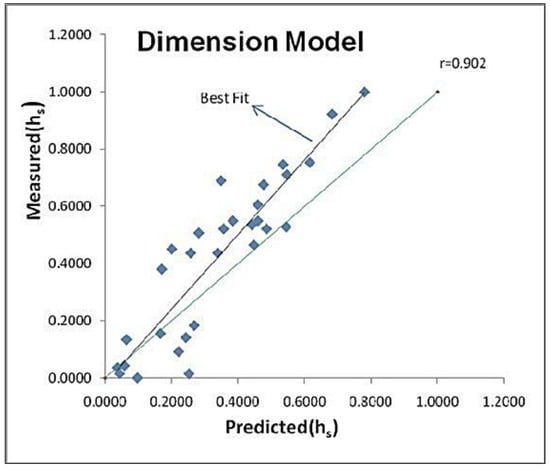
Figure 3.
Performance of the dimensional model when estimating the depth of the scour hole in the network with ten neurons in the hidden layer.
Considering the insignificant difference between the verification indicators of the networks with one and ten neurons in the hidden layer, the weights and biases of the network with one neuron are presented for ease of use:
| iw −4.7938 0.01147 −2.252 0.96372 0.72361 |
| lw −0.2154 |
| b1 0.94135 |
| b2 0.26149 |
9.3. Proposing a Relationship to Estimate the Scour Length
The related verification indicators are presented in Table 4.

Table 4.
Verification indicators of the dimensional model to estimate the length of the scour hole in networks with one and ten neurons in the hidden layer
The verification parameters of the network with ten neurons in the hidden layer were better than the network with one neuron in the hidden layer; consequently, the weights and biases of the network with ten neurons are presented as:
| iw 0.13954 −0.34703 −15.5455 −0.26827 0.25136 −43.5149 11.4334 26.5195 36.7548 3.5274 |
| 6.0547 2.0094 0.91448 −0.54972 −10.8109 |
| 7.8354 1.9898 26.5308 23.2199 −29.5445 |
| 2.8142 −1.4457 0.13635 0.14362 −0.044816 |
| 4.2529 −0.20599 0.34307 6.9064 0.14279 |
| 15.0312 −23.46 −35.6526 6.9185 −4.2878 |
| 1.4054 0.0003593 10.5808 9.8189 −0.82246 |
| 3.6569 −4.6905 0.35255 −3.4822 0.23934 |
| 3.673 7.2103 −9.84 2.8869 −14.0008 |
| lw −5.705 −0.024168 −0.23666 −0.052683 −3.8318 |
| 2.4468 −0.039192 0.10734 1.4926 0.25297 |
| b110 × 1−2.4279 |
| 3.2261 |
| −3.0193 |
| −31.399 |
| 0.32681 |
| −1.0797 |
| 14.2966 |
| −12.1405 |
| 2.4792 |
| 11.8944 |
| b2 −5.6428 |
9.4. Proposing a Relationship to Estimate the Scour Width
The related verification indicators are provided in Table 5. In addition, the performance of the dimensional model when estimating the width of the scour hole in the network with ten neurons in the hidden layer is depicted in Figure 4.

Table 5.
Verification indicators of the dimensional model when estimating the width of the scour hole in networks with one and ten neurons in the hidden layer.
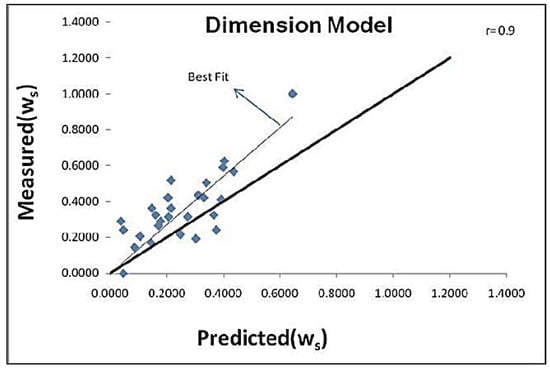
Figure 4.
Performance of the dimensional model when estimating the width of the scour hole in the network with ten neurons in the hidden layer.
The verification parameters of the network with ten neurons in the hidden layer were better than the network with one neuron in the hidden layer; therefore, the weights and biases of the network with ten neurons are presented as follows:
| iw 0.13954 −0.34703 −15.5455 −0.26827 0.25136 −43.5149 11.4334 26.5195 36.7548 3.5274 |
| 6.0547 2.0094 0.91448 −0.54972 −10.8109 |
| 7.8354 1.9898 26.5308 23.2199 −29.5445 |
| 2.8142 −1.4457 0.13635 0.14362 −0.044816 |
| 4.2529 −0.20599 0.34307 6.9064 0.14279 |
| 15.0312 −23.46 −35.6526 6.9185 −4.2878 |
| 1.4054 0.0003593 10.5808 9.8189 −0.82246 |
| 3.6569 −4.6905 0.35255 −3.4822 0.23934 |
| 3.673 7.2103 −9.84 2.8869 −14.0008 |
| lw −5.705 −0.024168 −0.23666 −0.052683 −3.8318 |
| 2.4468 −0.039192 0.10734 1.4926 0.25297 |
| b110 × 1 −2.4279 |
| 3.2261 |
| −3.0193 |
| −31.399 |
| 0.32681 |
| −1.0797 |
| 14.2966 |
| −12.1405 |
| 2.4792 |
| 11.8944 |
| b2 −5.6428 |
10. The Second Model (Dimensionless Parameters)
As mentioned in previous sections, using π-Buckingham’s theory, the obtained parameters were as shown in Equation (13).
10.1. Problem Inputs and Data Range (Considering All Analyzed Parameters)
The first model includes dimensional parameters used to estimate the height, length, and width of the scour hole. The inputs and data range are as shown in Table 6.

Table 6.
Problem inputs and data range in the dimensionless model with all input parameters.
10.2. Proposing a Relationship to Estimate the Scour Height
After the preparation of normalized inputs via the optimal network, verification indicators were obtained according to Table 7. Figure 5 depicts the performance of the dimensional model in estimating the height of the scour hole in the network with ten neurons in the hidden layer.

Table 7.
Verification indicators of the dimensionless model for estimating the height of the scour hole in networks with one and ten neurons in the hidden layer.
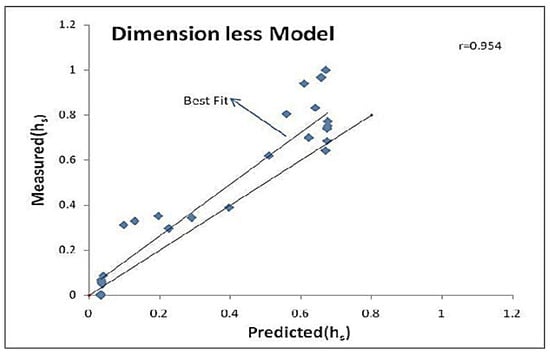
Figure 5.
Performance of the dimensionless model in estimating the height of the scour hole in the network with ten neurons in the hidden layer.
Considering that there is no significant difference between the verification parameters of networks with one and ten neurons in the hidden layer, the weights and biases of the network with one neuron in the hidden layer are presented as
| iw −39.7872 −0.034739 −0.020536 |
| lw −14.9571 |
| b1 −1.9605 |
| b2 −14.3687 |
10.3. Proposing a Relationship to Estimate the Scour Length
After the preparation of normalized inputs via the optimal network, verification indicators were obtained based on the data in Table 8. Figure 6 displays the performance of the dimensional model when estimating the length of the scour hole in the network with ten neurons in the hidden layer.

Table 8.
Verification indicators of the dimensionless model for estimating the length of the scour hole in networks with one and ten neurons in the hidden layer.
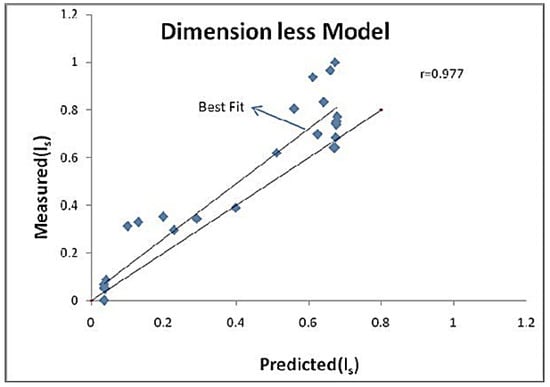
Figure 6.
Performance of the dimensionless model when estimating the length of the scour hole in the network with ten neurons in the hidden layer.
Given that no considerable difference is found between the verification parameters of networks with one and ten neurons in the hidden layer, the weights and biases of the network with one neuron in the hidden layer are expressed for ease of use:
| iw = [2.7141 1.114] 41,321.0 |
| lw = [0.27514] b1 = [−2.2937] b2 = [0.27265] |
10.4. Proposing a Relationship to Estimate the Scour Width
Following the preparation of normalized inputs via the optimal network, the verification indicators were obtained according to Table 9. Figure 7 illustrates the data related to the performance of the dimensionless model when estimating the length of the scour hole in the network with ten neurons in the hidden layer.

Table 9.
Verification indicators of the dimensionless model for estimating the width of the scour hole in networks with one and ten neurons in the hidden layer.

Figure 7.
Performance of the dimensionless model when estimating the width of the scour hole in the network with ten neurons in the hidden layer.
Considering the trivial difference between the verification parameters of networks with one and ten neurons in the hidden layer, the weights and biases of the network with one neuron in the hidden layer are presented as follows:
| iw = [2.2369 0.74602 −0.070153] |
| lw = [0.4215] b1 = [−1.7941] b2 = [0.40101] |
In the next few sections, a sensitivity analysis of dimensionless parameters has been conducted to investigate the importance of each input parameter for estimating the dimensions of the scour hole.
10.5. Problem Inputs and Data Range (Considering the Discharge, Hydraulic Radius, and Time)
This section examines the importance of input parameters in such a way that the combined (simultaneous) effect of discharge, time, and hydraulic radius is evaluated by removing a parameter such as the downstream depth. The inputs and data range are listed in Table 10.

Table 10.
Problem inputs and data range in the dimensionless model (considering the discharge and time)
10.6. Proposing a Relationship to Estimate the Scour Depth
After the preparation of normalized inputs by the optimal network, verification indicators were obtained based on the results in Table 11.

Table 11.
Verification indicators of the dimensionless model when estimating the height of the scour hole in the network with one neuron in the hidden layer (Inputs: discharge and time).
The weights and biases of each layer for one neuron at the first and second layers are as follows:
| iw = [2.0836] 96927.0 |
| lw = [0.43032] b1 = [−1.8341] b2 = [0.42186] |
10.7. Proposing a Relationship to Estimate the Scour Length
After the preparation of normalized inputs via the optimal network, verification indicators were achieved according to Table 12.

Table 12.
Verification indicators of the dimensionless model when estimating the length of the scour hole in the network with one neuron in the hidden layer (Inputs: discharge and time).
The weights and biases of each layer for one neuron at the first and second layers are
| iw = [2.6707 1.0615] |
| lw = [0.2766] b1 = [−2.183] b2 = [0.27328] |
10.8. Proposing a Relationship to Estimate the Scour Width
Following the preparation of normalized inputs via the optimal network, verification indicators were obtained based on Table 13.

Table 13.
Verification indicators of the dimensionless model when estimating the width of the scour hole in the network with one neuron in the hidden layer (Inputs: discharge and time).
The weights and biases of each layer for one neuron at the first and second layers are as follows:
| iw = [−2.3799 −0.84391] |
| lw = [−0.40819] b1 = [1.9426] b2 = [0.39318]5 |
10.9. Problem Inputs and Data Range (Considering the Discharge, Hydraulic Radius, Spillage Height, and Downstream Depth)
In the present and the following sections, the importance of input parameters is examined in such a way that the combined (simultaneous) effect of discharge, time, and hydraulic radius is investigated by removing a parameter such as the downstream depth. The inputs and data range are provided in Table 14:

Table 14.
Problem inputs and data range in the dimensionless model (considering the discharge, downstream depth, and spillage height).
10.10. Proposing a Relationship to Estimate the Scour Depth
After the preparation of normalized inputs via the optimal network, verification indicators were achieved according to the data in Table 15.

Table 15.
Verification indicators of the dimensionless model when estimating the depth of the scour hole in the network with one neuron in the hidden layer (Inputs: discharge, downstream depth, and spillage height).
The weights and biases of each layer for one neuron at the first and second layers are expressed as
| iw = [−6.0657 −3.1513] |
| lw = [−0.30208] |
| b1 = [5.3721] b2 = [0.33668] |
10.11. Proposing a Relationship to Estimate the Scour Length
Following the preparation of normalized inputs by the optimal network, verification indicators were obtained based on Table 16.

Table 16.
Verification indicators of dimensionless model when estimating the length of the scour hole in the network with one neuron in the hidden layer (Inputs: discharge, downstream depth, and spillage height).
The weights and biases of each layer for one neuron at the first and second layers are as follows:
| iw = [13.5355] 6894.5 |
| lw = [0.2103] b1 = [−10.633] b2 = [0.22864] |
10.12. Proposing a Relationship to Estimate the Scour Width
After the preparation of normalized inputs via the optimal network, verification indicators were achieved according to the results of Table 17. The weights and biases of each layer for one neuron at the first and second layers are
| iw = [−4.1125] 4906.1 |
| lw = [−0.31991] |
| b1 = [1.3956] b2 = [0.33135] |

Table 17.
Verification indicators of dimensionless model when estimating the width of the scour hole in the network with one neuron in the hidden layer (Inputs: discharge, downstream depth, and spillage height).
10.13. Regression Model
Most (previous) researchers have utilized empirical relationships to predict the dimensions of the scour hole downstream of hydraulic structures; accordingly, in this paper, the nonlinear and dimensionless regression relationships were obtained between the dimensionless parameters of scour hole dimensions using the data set which was utilized to train the neural network. The coefficients and verification indicators are presented in Table 18.

Table 18.
Coefficients and verification indicators of the regression model
According to the verification indicators in Table 18, the superiority of the neural network over the regression relationships is evident.
11. The Third Model (Parameters of DOT Relationship)
11.1. Problem Inputs and Data Range (Considering All Analyzed Parameters)
The first model includes dimensional parameters used to estimate the height, length, and width of the scour hole. The inputs and data range are presented in Table 19.

Table 19.
Problem inputs and data range in DOT model (considering all parameters).
11.2. Proposing a Relationship to Estimate the Scour Depth
Due to the importance of scour height in comparison to other dimensions of the scour hole in the design of hydraulic structures, the SPSS software was used to evaluate the constructed (prepared) network in order to estimate the height of the scour hole in two models according to Table 20. In addition, the performance of the DOT model when estimating the height of the scour hole in the network with one neuron in the hidden layer is displayed in Figure 8.

Table 20.
Verification indicators of the DOT model when estimating the depth of the scour hole in networks with one and ten neurons in the hidden layer.
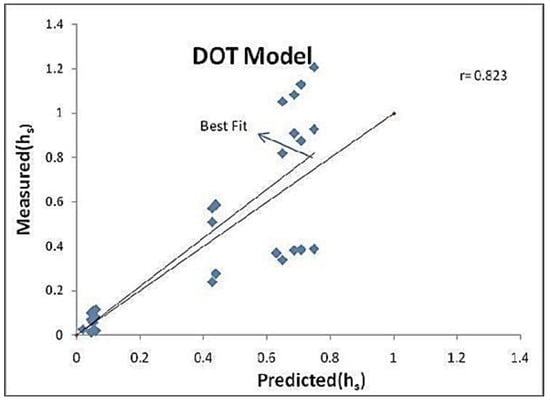
Figure 8.
Performance of the DOT model when estimating the height of the scour hole in the network with one neuron in the hidden layer.
According to the above tables, there is no significant difference between the verification indicators of networks with one and ten neurons in the hidden layer. Hence, only the weights and biases of each layer for a neuron in the first and second layers are presented for ease of use:
| iw = [2.7332 1.1145] lw = [0.37603] b1 = [−2.5149] b2 = [0.40032] |
11.3. Proposing a Relationship to Estimate the Scour Length
After the preparation of normalized inputs via the optimal network, verification indicators were obtained according to Table 21. Figure 9 displays the performance of the DOT model when estimating the length of the scour hole in the network with one neuron in the hidden layer. Based on the results, the DOT model was proven to be a suitable model for determining the height of the scour with one neuron in the hidden layer.

Table 21.
Verification indicators of the DOT model when estimating the length of the scour hole in networks with one and ten neurons in the hidden layer.
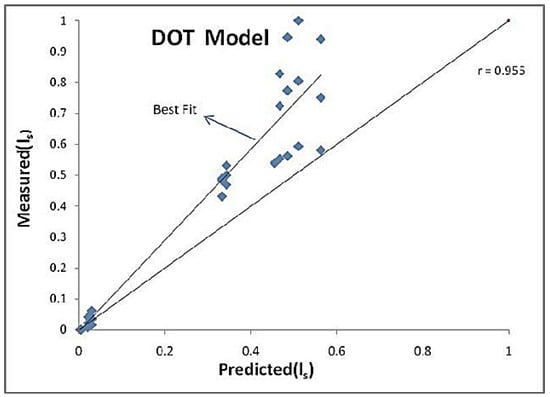
Figure 9.
Performance of the DOT model when estimating the length of the scour hole in the network with one neuron in the hidden layer.
According to the obtained data, the verification indicators of networks with one and ten neurons in the hidden layer are not significantly different from each other. Thus, only the weights and biases of each layer for one neuron in the first and second layers are provided for ease of use:
| iw = [2.226 ]58187.0 lw = [0.30018] b1 = [−2.0164] b2 = [0.29304] |
11.4. Proposing a Relationship to Estimate the Scour Width
After the preparation of normalized inputs via the optimal network, verification indicators were obtained based on the data in Table 22. Moreover, Figure 10 illustrates the performance of the DOT model in estimating the width of the scour hole in the network with one neuron in the hidden layer. Regarding the performance of the DOT model, a high correlation was found between measured and predicted data (r coefficient equals 96%). Thus, the DOT model could determine the length of the scour hole.

Table 22.
Verification indicators of the DOT model when estimating the width of the scour hole in networks with one and ten neurons in the hidden layer.
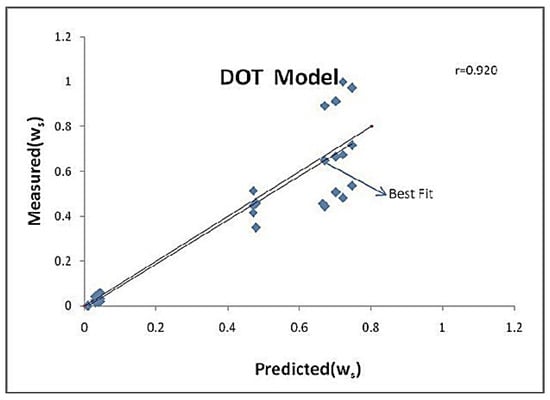
Figure 10.
Performance of the DOT model when estimating the width of the scour hole in the network with one neuron in the hidden layer.
According to the above tables, there is no considerable difference between verification indicators of the networks with one and ten neurons in the hidden layer. Therefore, only the weights and biases of each layer for a neuron in the first and second layers are presented for ease of use:
| iw = [2.227] 32157.0 lw= [0.42603] b1 = [−2.0122] b2 = [0.41858] |
12. The Fourth Model (Modified Parameters of DOT Relationship by Mahdavizadeh et al. [9]
As mentioned in previous sections, based on studies conducted by Mahdavizadeh et al. [9], some modifications were made to the presented DOT relationship, and the most major modification was related to the Ch coefficient (correction coefficient for dischargers placed above the bed).
12.1. Problem Inputs and Data Range (Considering All Analyzed Parameters)
The first model includes dimensional parameters for estimating the height, length, and width of the scour hole. The inputs and data range are listed in Table 23.

Table 23.
Problem inputs and data range in the modified DOT model (considering all parameters).
12.2. Proposing a Relationship to Estimate the Scour Depth
Due to the importance of scour height compared to other dimensions of the scour hole when designing hydraulic structures, the SPSS software was employed to evaluate the constructed (prepared) network in order to estimate the height of the scour hole in two models according to Table 24. Figure 11 depicts the performance of the modified DOT model when estimating the height of the scour hole in the network with ten neurons in the hidden layer.

Table 24.
Verification indicators of the modified DOT model when estimating the depth of the scour hole in networks with one and ten neurons in the hidden layer.
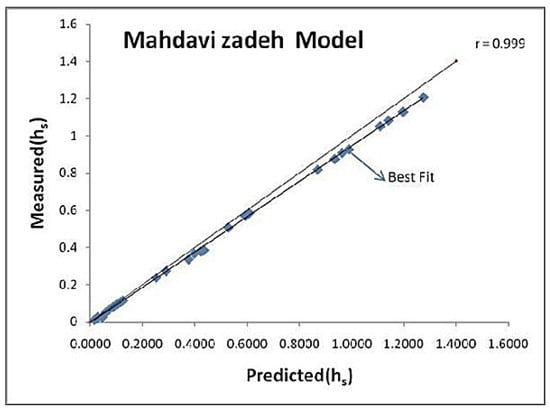
Figure 11.
Performance of the modified DOT model in estimating the height of the scour hole in the network with ten neurons in the hidden layer
According to the above tables, the verification indicators for the network with ten neurons in the hidden layer were considerably better than the network with one neuron in the hidden layer, and the weights and biases of each layer for the network with ten neurons are presented accordingly.
The weights and biases of each layer for ten neurons in the first layer and one neuron in the second layer are as follows:
12.3. Proposing a Relationship to Estimate the Scour Length
Following the preparation of normalized inputs via the optimal network, verification indicators were achieved according to the results of Table 25. Figure 12 illustrates the performance of the modified DOT model when estimating the length of the scour hole in the network with ten neurons in the hidden layer.

Table 25.
Verification indicators of the modified DOT model when estimating the length of the scour hole in networks with one and ten neurons in the hidden layer.
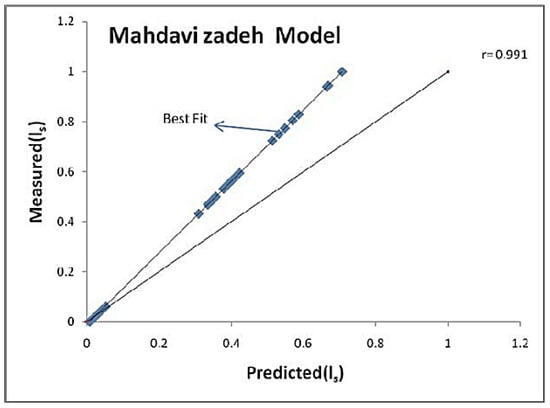
Figure 12.
Performance of the modified DOT model when estimating the length of the scour hole in the network with ten neurons in the hidden layer.
According to the obtained data, the verification indicators of the network with ten neurons in the hidden layer were significantly better than those of the network with one neuron in the hidden layer, and the weights and biases of each layer for the network with ten neurons are provided as follows:
12.4. Proposing a Relationship to Estimate the Scour Width
After the preparation of normalized inputs via the optimal network, verification indicators were obtained based on Table 26. In addition, the performance of the modified DOT model when estimating the height of the scour hole in the network with ten neurons in the hidden layer is shown in Figure 13.

Table 26.
Verification indicators of the modified DOT model when estimating the width of the scour hole in networks with one and ten neurons in the hidden layer
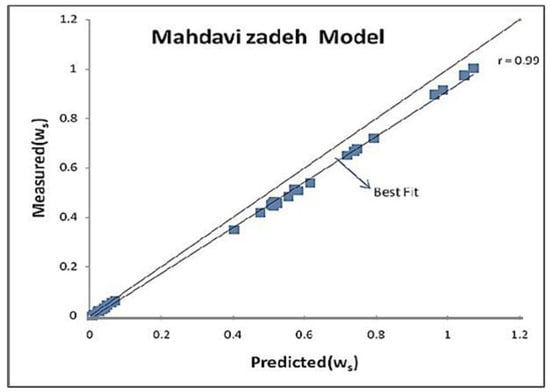
Figure 13.
Performance of the modified DOT model when estimating the width of the scour hole in the network with ten neurons in the hidden layer.
Based on the results of previous tables, the verification indicators of the network with ten neurons in the hidden layer were noticeably better than those of the network with one neuron in the hidden layer, and the weights and biases of each layer for the network with ten neurons are presented accordingly. Moreover, the results show when we increase the neurons from 1 to 10, although there is good agreement between measured and predicted data (r values changed from 0.92 to 0.91) when we consider Table 26 as the sample, the RMSE values represented an extreme increase (from 0.06 to 50). Thus, for all the models, RMSE highly increases when we increase the neurons. The authors suggested that it is better to use from one to a maximum of ten neurons with a hidden layer to predict the phenomena presented in this paper. Finally, the results revealed that, to determine the width of the scour, the modified DOT model has the best agreement with Mahdavizadeh et al. [9] measured data. It is recommended that the modified DOT model should be used to evaluate scour phenomena in downstream of a tree trunk deflector in a straight channel.
13. Conclusions
Mahdavizadeh et al.’s [9] laboratory values were used to model the neural network, and the the DOT relationship was investigated; next, by considering the structure of one neuron in the hidden layer, a comparison was made between the DOT relationship and the modified DOT relationship, according to Mahdavizadeh et al. [9]. It was observed that modified DOT had a higher correlation and a lower MSE for all dimensions of the scour hole in comparison with the DOT relationship according to data in Table 27 and Table 28.

Table 27.
Verification indicators for dimensions of the scour hole for one and ten neurons in the hidden layer for dimensional input parameters.

Table 28.
Verification indicators for dimensions of the scour hole for one and ten neurons in the hidden layer for dimensionless input parameters.
The comparison of ANN and nonlinear regression models according to Table 28 and Table 29 demonstrates a higher accuracy and capability of ANNs in the simulation of the phenomenon.

Table 29.
Verification indicators for dimensions of the scour hole for the regression dimensionless model.
Despite the superiority of the dimensionless model over the dimensional model, in the next step, the sensitivity analysis was performed on the dimensionless model and were considered as input parameters. Based on the results, the effect of downstream depth and the spillage height on the height of the scour hole was noticeable because verification indicators (Table 28) were changed in comparison with the state that all parameters were considered input parameters. In the next case, considering the input parameters and relying on the verification indicators (Table 28), the effect of time on the width of the scour hole was considerably greater than that of the length and height of the scour hole.
It should be noted that laboratory values reported by Mahdavizadeh [9] were utilized to model the neural network, and investigations were conducted on the DOT relationship. Accordingly, the DOT relationship and the modified DOT relationship (presented by Mahdavizadeh et al. [9].) were compared by considering the structure of one neuron in the hidden layer. It was observed that the modified DOT has a higher correlation and a lower MSE in all dimensions of the scour hole compared to the DOT relationship (Table 30 and Table 31).

Table 30.
Verification indicators for dimensions of the scour hole for one and ten neurons in the hidden layer for the input parameters of the DOT relationship.

Table 31.
Verification indicators for dimensions of the scour hole for one and ten neurons in the hidden layer for the input parameters of the modified DOT relationship.
Despite the superiority of the modified DOT model, a network with ten neurons in the hidden layer was constructed (prepared) to provide the relationships to estimate the dimensions of the scour hole downstream of the tree trunk deflector due to the culvert. The weights and biases were based on the sigmoid transfer function and the linear transfer function in the first and second layers, respectively. The whole relationship is as follows:
| Objective purelin = lw × tansig iw × input b1 b2 (1-)6 |
Author Contributions
Conceptualization, M.N. and S.M.M.H.; methodology, H.R.; software, H.R.; validation, H.R., M.N. and S.M.M.H.; formal analysis, S.M.M.H.; investigation, M.N.; resources, H.R.; writing—original draft preparation, H.R.; writing—review and editing, M.N.; supervision, M.N.; project administration, S.M.M.H.; funding acquisition, H.R. All authors have read and agreed to the published version of the manuscript
Funding
This research received no external funding.
Data Availability Statement
The details regarding data supporting reported results can be found in [9].
Conflicts of Interest
The authors declare no conflict of interest.
References
- Akbarifard, S.; Akhound Ali, A.M. Sea Wave Height Simulation Using Meta Heuristic Algorithms in Chabahar Region. Darya-Fonoun Sci.-Res. Q. 2017, 4, 73–84. (In Persian) [Google Scholar]
- Amini, M.; Heydarpour, M. Investigating the application of the combined collar and gap model in controlling and reducing the local scour in the group of cylindrical bridge piers. In Proceedings of the 7th Sustainable Agriculture and Natural Resources Conference, Tehran, Iran, 20 May 2017. (In Persian). [Google Scholar]
- Rajabi, D.; Karami, H.; Hosseini, K.; Mousavi, F.; Hashemi, A.A. Estimating the optimal parameters of the nonlinear Muskingum Routing model using the imperialist competition algorithm. J. Water Soil Sci. Agric. Nat. Resour. Sci. Tech. 2015, 19, 321–333. (In Persian) [Google Scholar]
- Hashemi Monfared, S.A.; Hosseinzadeh, F.; Pirzadeh, B. The use of imperialist competition algorithm in the optimization of reservoir operation with the aim of maximizing the supply of demand (a case study of the Pishin dam). Hydraul. Sci.-Res. J. 2017, 12, 59–67. (In Persian) [Google Scholar]
- Amini, A.; Mohammad, T.A. Local scour prediction around piers with complex geometry. Mar. Georesour. Geotechnol. 2017, 35, 857–864. [Google Scholar] [CrossRef]
- Kashani, A.R.; Gandomi, A.H.; Mousavi, M. Imperialistic competitive algorithm: A metaheuristic algorithm for locating the critical slip surface in 2-dimensional soil slopes. Geosci. Front. 2016, 7, 83–89. [Google Scholar] [CrossRef]
- Moussa, A.M.A. Evaluation of local scour around bridge piers for various geometrical shapes using mathematical models. Ain Shams Eng. J. 2018, 9, 2571–2580. [Google Scholar] [CrossRef]
- Saber, N.A.; Salimi, M.; Mirabbasi, D. A priority list based approach for solving thermal unit commitment problem with novel hybrid genetic-imperialist competitive algorithm. Energy 2016, 117, 272–280. [Google Scholar] [CrossRef]
- Mahdavizadeh, M.; Tafarojnoruz, A.; Lim, S.Y. Prediction of local scour depth downstream of sluice gates using data-driven models. ISH J. Hydraul. Eng. 2017, 23, 195–202. [Google Scholar] [CrossRef]
- Mahdavizadeh, M.; Lim, S.Y. Application of improved neuro-fuzzy GMDH to predict scour depth at sluice gates. Earth Sci. Inform. 2015, 8, 187–196. [Google Scholar] [CrossRef]
- Ali, H.M.; El Gendy, M.M.; Mirdan, A.M.H.; Ali, A.A.M.; Abdelhaleem, F.S.F. Minimizing downstream scour due to submerged hydraulic jump using corrugated aprons. Ain Shams Eng. J. 2014, 5, 1059–1069. [Google Scholar] [CrossRef]
- Shen, H.W.; Schneider, V.R.; Karaki, S. Local scour around bridge piers. Proc. ASCE 1969, 95, 1919–1940. [Google Scholar] [CrossRef]
- Jain, S.C.; Fischer, E.E. Scour around Bridge Piers at High Froude Numbers; Report No. FHWA-RD-79-104; Federal Highway Administration: Washington, DC, USA, 1979. [Google Scholar]
- Froehlich, D.C. Local scour at bridge abutments. In Proceedings of the 1989 National Conference on Hydraulic Engineering, New Orleans, LA, USA, 14–18 August 1989; pp. 13–18. [Google Scholar]
- Melville, B.W.; Sutherland, A.J. Design method for local scour at bridge piers. J. Hydraul. Eng. 1988, 114, 1210–1226. [Google Scholar] [CrossRef]
- Jones, J.S. Comparison of prediction equations for bridge pier and abutment scour. In Proceedings of the Transportation Research Record, Second Bridge Engineering Conference, Minneapolis, MN, USA, 24–26 September 1984; Transportation Research Board: Washington, DC, USA, 1984; Volume 2, pp. 202–209. [Google Scholar]
- Johnson, P.A. Comparison of pier-scour equations using fielddata. J. Hydraul. Eng. 1995, 121, 626–629. [Google Scholar] [CrossRef]
- Ben Meftah, M.; Mossa, M. New approach to predicting local scour downstream of Grade-control structure. J. Hydraul. Eng. 2020, 146, 04019058. [Google Scholar] [CrossRef]
- Ben Meftah, M.; De Padova, D.; De Serio, F.; Mossa, M. Secondary currents with scour hole at grade control structures. Water 2021, 13, 319. [Google Scholar] [CrossRef]
- Ben Meftah, M.; De Serio, F.; De Padova, D.; Mossa, M. Hydrodynamic structure with scour hole downstream of bed sills. Water 2020, 12, 186. [Google Scholar] [CrossRef]
Disclaimer/Publisher’s Note: The statements, opinions and data contained in all publications are solely those of the individual author(s) and contributor(s) and not of MDPI and/or the editor(s). MDPI and/or the editor(s) disclaim responsibility for any injury to people or property resulting from any ideas, methods, instructions or products referred to in the content. |
© 2023 by the authors. Licensee MDPI, Basel, Switzerland. This article is an open access article distributed under the terms and conditions of the Creative Commons Attribution (CC BY) license (https://creativecommons.org/licenses/by/4.0/).